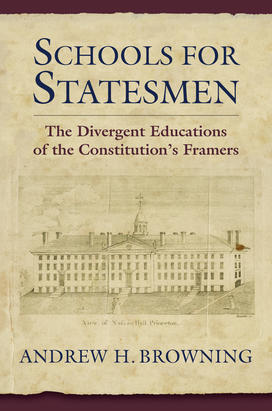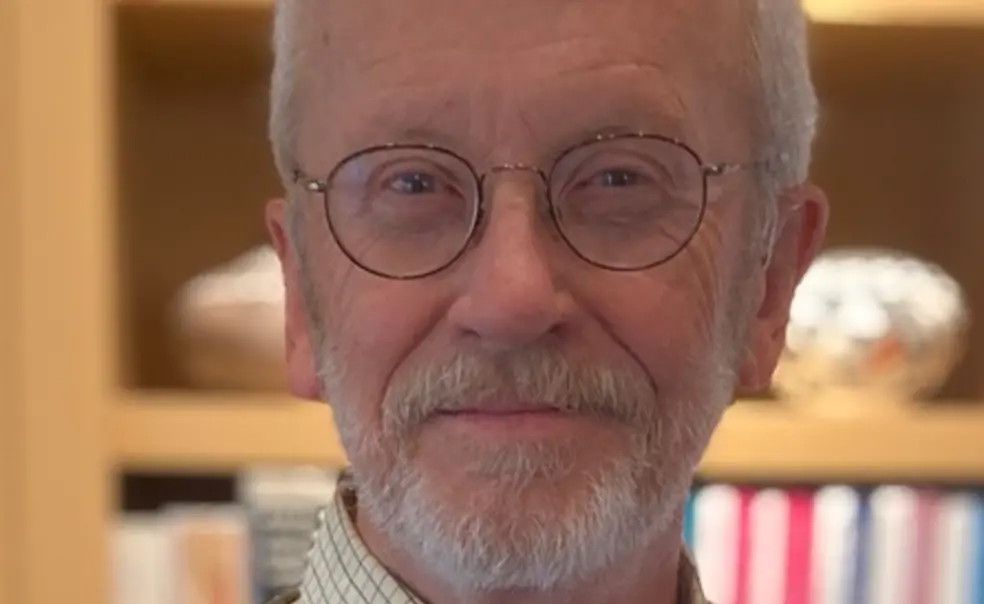Andrew Browning ’71 Examines the Impact of Alumni on the U.S. Constitution
The book: Schools for Statesmen (University Press of Kansas) examines the educations of the 55 men who helped draft the U.S. Constitution. With educational experiences ranging from traditional conservative curriculum to more liberal ones, author Andrew Browning ’71 sheds new light on the impact of the framers’ education on their various positions at the 1787 Constitutional Convention. Analyzing the diverse educational world of the 18th century, Browning’s analysis highlights the convention’s forward-thinking innovators — including the central role that Princetonians played in the creation of the Constitution (nine of the framers were Princeton alumni).

The author: Andrew Browning ’71 earned his undergraduate degree in philosophy from Princeton and his Ph.D. from the University of Virginia. He previously taught history in Washington, D.C., Honolulu, and Portland, Oregon. He’s the author of The Panic of 1819: The First Great Depression and has written for various scholarly journals.
Excerpt:
Princeton in the Nation’s Service
The College of New Jersey
Gunning Bedford Jr., William Richardson Davie, Jonathan Dayton, Oliver Ellsworth, William Churchill Huston, James Madison, Alexander Martin, Luther Martin, William Paterson
“No College has turned out better scholars, or more estimable characters, than Nassau.” — George Washington to George Washing Parke Custis, July 23, 1797
In May 1787, a convention meeting in Philadelphia drew up a constitution that created a federal system, based on proportional representation in a national legislature, with a single chief executive and a limited government deriving its authority from the people. This was not the Constitution of the United States—that would require another fifteen weeks of contentious debate—but the Constitution of the Presbyterian Church in the United States. The author of its introduction, chosen to be the chief executive (“moderator”) of the Presbyterians, was John Witherspoon, president of the College of New Jersey. He would surely have been a delegate to the Federal Convention in 1787 if he hadn’t been committed a year in advance to the Presbyterians’ convention, meeting only blocks away; he arrived in Philadelphia on May 18, and New Jersey’s Framers began arriving on May 25.
Witherspoon’s influence extended far beyond the academic world; his friend Ezra Stiles considered him a “very learned divine” but thought he was too much engaged in politics. In the Continental Congress, Witherspoon voted for independence and signed the Declaration. Already in 1776 he was concerned about the need for a “lasting confederacy,” and in 1778 he signed the Articles of Confederation. It is a measure of the confidence Congress had in Witherspoon that in 1781 he was chosen to draft the instructions to the American peace commissioners in Paris: Franklin, Adams, Jefferson, and Henry Laurens.
In 1786, Madison stopped on his way from New York to the Annapolis Convention to confer with “the old doctor.” Other Framers who were not former students also sought his advice. In 1784, Washington wrote one of his longest personal letters to Witherspoon, discussing the settlement of western lands; he too stopped to see him in Princeton, on his 1789 journey from Virginia to his inauguration. Historian Fred J. Hood finds an “amazing similarity” between Witherspoon’s Lectures on Moral Philosophy and Hamilton’s draft of Washington’s Farewell Address, enough to make Witherspoon’s influence “immediately apparent” to Hood. (In 1796, Washington had given Hamilton Madison’s earlier draft of such an address to work from.) There is no evidence that Hamilton ever saw a copy of Witherspoon’s lectures, which were not yet in print, but Witherspoon had published An Essay on Money as a Medium of Commerce, which led Hamilton to write to him in October 1789 seeking suggestions for “a proper provision for the public Debt” and “public Credit.” The editors of Hamilton’s Papers note that his first and second Treasury Reports of 1790 contain ideas that “closely resemble the ideas advanced by John Witherspoon in his letter to the Secretary of the Treasury.”
One in six of the Framers was a graduate of the New Jersey college, already better known from its location simply as Princeton or, from its imposing main building, as Nassau Hall. At the school’s sesquicentennial in 1896, when the name was formally changed to Princeton University, Woodrow Wilson acknowledged that “[it] would be absurd to pretend that we can distinguish Princeton’s touch and method in the Revolution. . . . [But Princeton] outranked her elder rivals in the roll call of the Constitutional Convention, and seemed for a little, a seminary of statesmen rather than a quiet seat of academic learning.” Witherspoon, president of the college from 1768 until 1794, is a large part of the reason, though by no means all of it.
Madison (author of the Virginia Plan) studied under Witherspoon, as did Bedford, Davie, and Dayton. Paterson (author of the competing New Jersey Plan) and Ellsworth (manager of the Great Compromise between those plans) graduated before his arrival, as did Alexander Martin, the unrelated Luther Martin, and William Churchill Houston, who taught under Witherspoon and served with him in Congress. These Framers and their Princeton classmates were a more denominationally, economically, and geographically diverse group than the graduates of other colleges. Paterson was born in Ireland and Davie in England, both coming to America in early childhood. Madison was a Virginia planter’s son; Davie and Houston were raised on modest North Carolina farms. Bedford was a city boy, son of a Philadelphia carpenter, and both Martins were sons of New Jersey farmers. The fathers of Paterson and Dayton were merchants in New Jersey, and Ellsworth was the son of a Connecticut farmer and grandson of a tavern keeper. Such backgrounds were not unusual at Princeton. Between 1769 and 1775 more than a third of the students were farmers’ sons, one in six was a merchant’s son, and only one in eight had a father identified as a “gentleman.” At a time when virtually all William and Mary students were Virginians, when 90 percent of Harvard’s students came from Massachusetts and more than 80 percent of Yale’s were from Connecticut, Princeton’s student body came from up and down the Atlantic Seaboard and from the West Indies.
Before Witherspoon, half of the graduates became clergymen; lawyers accounted for forty-nine graduates and physicians nearly as many. Among Witherspoon’s students, lawyers outnumbered ministers. The nine Princeton Framers represented Connecticut, New Jersey, Delaware, Maryland, Virginia, and North Carolina at the Convention; all except Madison were lawyers, but Houston had just left a career as a teacher, Davie owned plantations in the Carolinas, and Dayton was embarking on a lifetime of land speculation. Princeton graduates were especially likely to be politically active: the two classes of 1771 and 1772 alone, with a combined thirty-three graduates, produced a president (Madison), a vice president (Burr), a US attorney general (William Bradford), a secretary of state (Madison again), and three members of Congress. This was not just the influence of Witherspoon: the five classes immediately before he arrived in 1768 (a total of eighty-seven graduates) yielded nine members of Congress from eight states, two justices of the US Supreme Court (Paterson and Ellsworth), and judges of the supreme courts of five states. These numbers are all the more remarkable given that Princeton was barely half the size of Harvard or Yale. During the 1760s, Harvard and Yale typically graduated between thirty and forty-five students each year, Princeton fifteen to twenty. Madison and Bedford were two of only eleven members of the class of 1771.
Excerpt from School’s for Statesmen: The Divergent Educations of the Constitution’s Framers by Andrew H. Browning, published by the University Press of Kansas, © 2022. www.kansaspress.ku.edu. Used by permission of publisher.
Review:
“Schools for Statesmen constitutes the most comprehensive analysis ever published of the education of the Framers of the U.S. Constitution. Its detailed account of the Framers’ tutors, grammar schools, colleges, and legal training is unparalleled. Its thesis — that the close personal connections between Framers of different states that were formed at colonial colleges, in combination with the ideas they imbibed together there, played a crucial role in the momentous decisions they reached at the Constitutional Convention — is especially provocative.” — Carl Richard, author of The Founders and the Classics: Greece, Rome, and the American Enlightenment












1 Response
Norman Ravitch *62
3 Years AgoBackground on the Declaration of Independence
According to superb British historian Andrew Roberts, in his book The Last King of America: The Misunderstood Reign of George III, of the some 28 crimes of George III against the American colonists as laid out by Jefferson in the Declaration of Independence at least 26 were outright lies and obvious propaganda and the other two at least questionable. This should tell us something about the subsequent Articles of Confederation and then the Constitution. You don’t have to be a present day lover of the British, who have come down a great deal in recent years, to admit being against the American Revolution lock, stock, and barrel. I certainly do — both before this excellent book on George III and even more so afterwards.